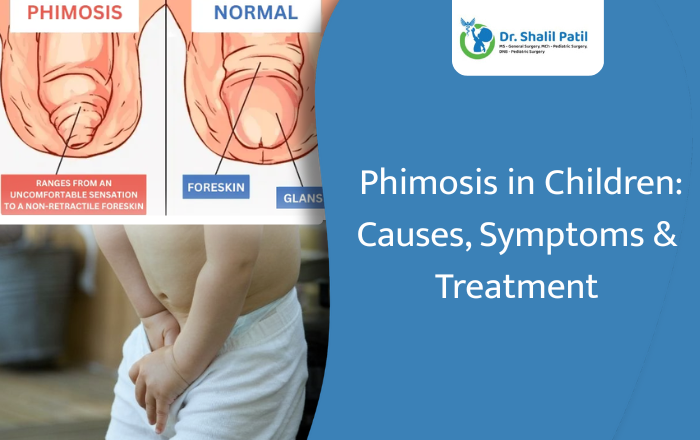If you’ve recently noticed your child having trouble pulling back their foreskin, or they complain of pain while urinating, you might be worried. Many parents come across the term “phimosis in children” for the first time in such situations. The truth is, in many cases, phimosis is a normal part of development — but sometimes, it can be a sign of a problem that needs attention.
This blog will walk you through what phimosis is, why it happens, the symptoms to look for, and the treatment options available.
What is Phimosis in Children?
Phimosis is when the foreskin of the penis cannot be pulled back over the head (glans). In newborns and younger boys, this is usually normal and called physiological phimosis. The foreskin naturally becomes more retractable with age, often without any treatment.
However, if the foreskin becomes scarred, tight, or causes problems, it’s called pathological phimosis, which may require medical care.
Causes of Phimosis in Children
- Natural developmental stage
At birth, the foreskin is usually attached to the glans and cannot be retracted. Over time, natural separation occurs. For many boys, this happens gradually up to the age of 7–10 years.
- Poor hygiene or infections
If the foreskin is not cleaned properly (without forceful retraction), smegma — a whitish substance made of dead skin cells — can build up. This may lead to infections, swelling, and scarring.
- Inflammatory skin conditions
Conditions like balanitis (inflammation of the glans) or lichen sclerosus can cause the foreskin to tighten over time.
- Forceful retraction
Trying to pull back the foreskin before it’s ready can cause small tears, pain, and scarring, which may lead to phimosis.
Symptoms to Watch Out For
Not all cases of phimosis cause symptoms. But you should watch for:
- Pain or swelling in the foreskin
- Difficulty urinating or ballooning of the foreskin during urination
- Redness, soreness, or repeated infections
- Bleeding or white scar tissue at the foreskin tip
When to See a Doctor
While physiological phimosis is often harmless, you should consult a doctor if your child has:
- Ongoing pain or swelling
- Trouble passing urine
- Recurrent infections
- Tight foreskin beyond the expected age range, especially if it’s worsening
Treatment Options for Phimosis in Children
- Observation and reassurance
If it’s physiological phimosis and there are no symptoms, a doctor might simply suggest waiting and monitoring as it often improves naturally.
- Gentle daily care and hygiene
Clean the penis with warm water, avoiding any attempt to forcefully retract the foreskin. Once it becomes naturally retractable, gentle cleaning underneath is important.
- Topical steroid creams
These can help soften the foreskin and make retraction easier over time. This treatment is painless and usually used for a few weeks as prescribed by a doctor.
- Minor surgical options
If creams don’t work or the phimosis is severe, minor procedures like preputioplasty (loosening the foreskin) or circumcision may be recommended.
Myths vs Facts About Phimosis
Myth: All boys should have a fully retractable foreskin by age 3.
Fact: Many boys don’t achieve full retraction until later in childhood.
Myth: Circumcision is the only treatment for phimosis.
Fact: Many cases are treated successfully with creams and hygiene measures.
Myth: Phimosis always causes pain.
Fact: Physiological phimosis is usually painless and harmless.
FAQs
Q1. Is phimosis painful for children?
Not always. Physiological phimosis is usually painless, but pathological phimosis can cause discomfort.
Q2. At what age should the foreskin fully retract?
It varies, but for many boys, the foreskin becomes fully retractable between 7 and 10 years of age.
Q3. Can phimosis cause long-term problems?
If untreated pathological phimosis continues, it may lead to repeated infections or difficulty urinating.
Q4. Are home remedies safe for treating phimosis?
Gentle hygiene is safe, but creams or treatments should only be used after consulting a doctor.
Worried About Phimosis? Get the Right Help for Your Child Today
Phimosis in children can be completely normal, but it’s important to know when to get it checked. If you’re unsure or notice troubling symptoms, timely medical advice can make a big difference.
For guidance and treatment, you can consult Dr. Shalil Patil — Pediatric Urologist in Virar, who has extensive experience in managing foreskin conditions in children with care and understanding.




